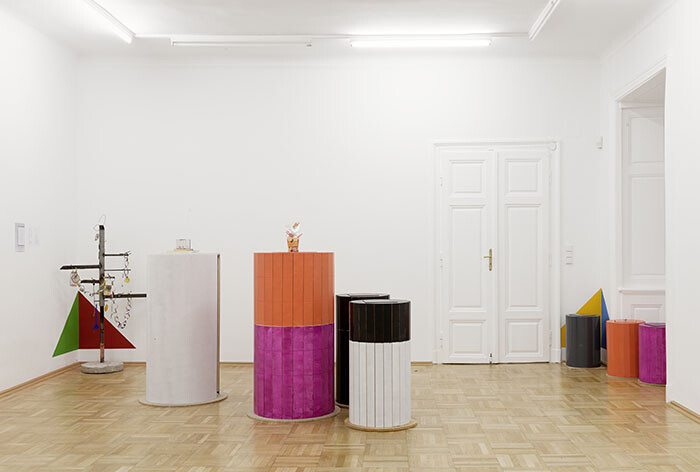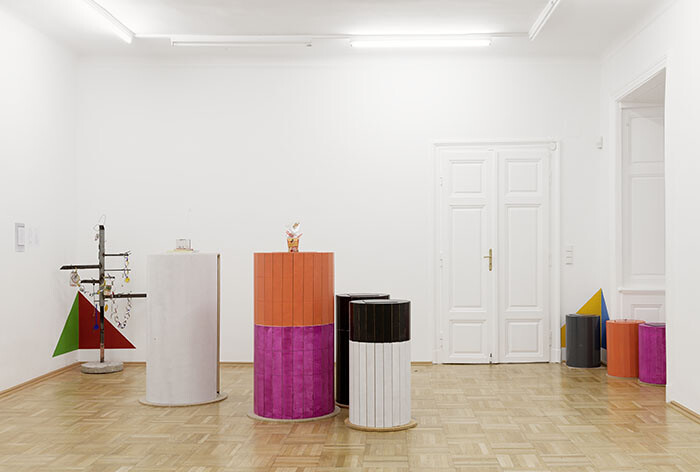What exactly a Scottish bagpipe player was doing performing at a Manfred Pernice opening was not immediately clear to me, nor perhaps to anyone else who was there. And yet, seeing the musician periodically march out and solemnly blow into and kneed his large, bladder-shaped bag among a group of Pernice sculptures somehow made perfect, if oblique, sense. But why? Perhaps it had something to do with Pernice’s marginalization of cultural specificity, and the retiring and essentially atmospheric nature of his work. Indeed, for his fifth show at this venerable Viennese apartment gallery, the German sculptor seemed to want to create a semi-depressed club-like setting, as if his work were not actually the main event, but the delightfully dismal backdrop to it. As such, the works carried out a specious flattening that dallied with—but humbly declined—to be flattened.
In the main space, which was sparsely outfitted with several large MDF cylinders painted or covered with fabric evocative of, say, standing bar tables and trashcans, the works seemed to assume the position of backdrop. Brightly painted, smaller, stool-sized versions of the cylinders could be found in corners, while in another angle lurked the bleakest and most captivating Christmas tree I’ve ever seen. Made from welded metal with a concrete basin and upon whose branches were draped decorative garlands contrived from beer cans, this detrital surrogate would likely drive any holiday-besotted toddler to tears. But, as if to redeem any such holiday despair, the cylinders standing nearby were full of surprises. When not festooned with tchotchkes or totemic piles of trash, their flat tops, which contained low, inset boxes, could be accessed by lifting the lids up, revealing all manner of seemingly garage-derived minutiae, from German paperbacks, to empty and crushed plastic water bottles, to unused pictures frames.
The second room featured a large series of collages in small, gray, square display cases with glass coverings (with the materials placed inside, loose and unfixed). Systematically hung in close quarters over larger squares of primary colors painted directly on the wall behind them, the cases contained everything from pieces of fabric, newspaper clippings, images of the sculptures in the next room, or occasionally, nothing. A personal favorite boasted of nothing more than an unfolded pink paper napkin with a kitschy floral motif, which functioned as a perfect distillation of the sense of incidental specificity that characterizes Pernice’s work. Meanwhile, the last room of the show continued to evoke the spirit of the garage, with three sculptures, one in two parts, with a kind of lamp and an amalgam of other materials hanging from the ceiling above a signature Pernice MDF unpainted platform with an inverted mountain bike on it.
This show is strong not only because it is formally united by an appreciably pathological and understated motif of “containing.” Complemented by a Benjaminian valorization of flotsam and jetsam—and an at times seemingly accidental yet totally relentless black humor—this work’s sheer range is its strength, as well as its capacity for paradox and formal resolution. For instance, Pernice is one of the few artists of the past decade who has zero need to justify his use of MDF—it just makes sense. Literally trashing minimalism, these works deflate the high seriousness of modern sculpture while nevertheless seriously engaging it on its own terms. These latter are as marginal as they provisional, which is to say that the work is marked by a willful marginality, influenced in equal parts by the recycled aesthetic of the second-hand store (or garage sale), anonymous, urban vernacular architectural elements, and a general sense of things being “under construction.” Although eschewing the supposed conclusiveness of minimalism’s total, Q.E.D. rejection of narrative, this work could not be said to be lacking in conviction, while nevertheless casually incorporating narrative on almost every level, and, even more importantly, reveling in its own provisional constructed-ness. And this is refreshing. For in an era increasingly dominated by a kind of performative provisionality, in which a given work must hold it together just long enough to be photographed (and photoshopped), Pernice’s sculpture is (anti-)heroically classical by virtue of its natural resistance to the two-dimensional.











